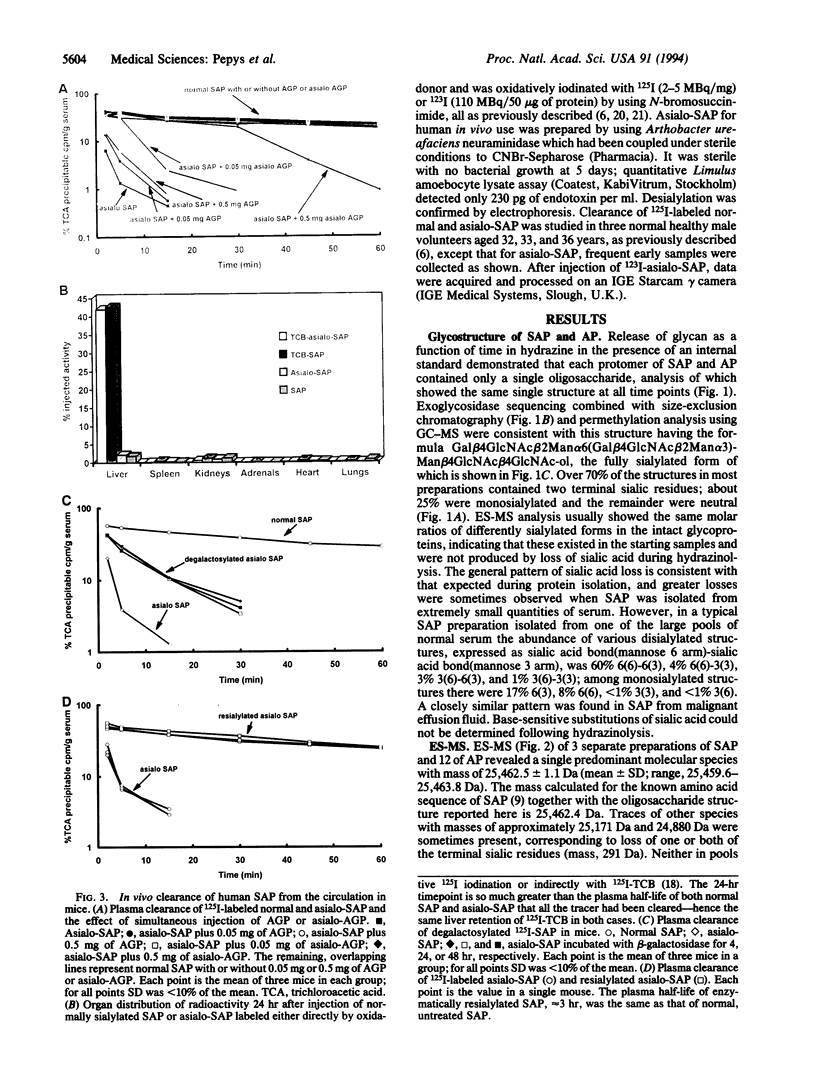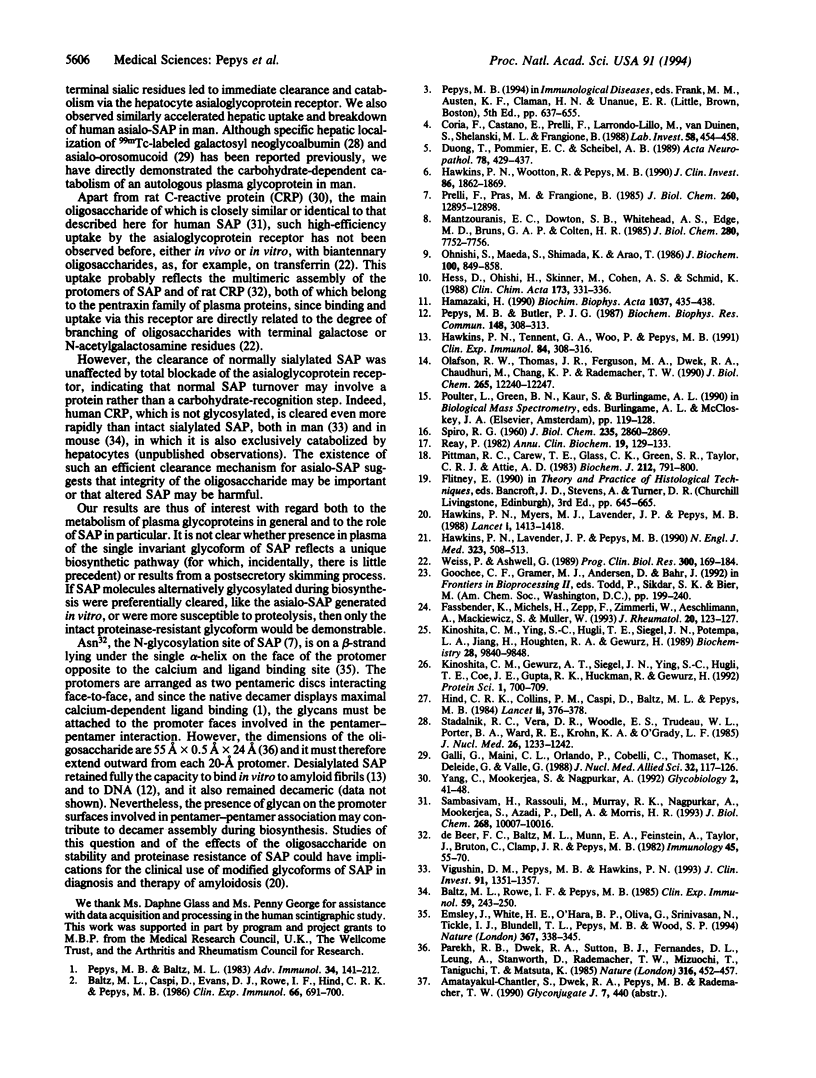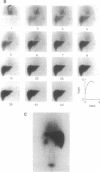Abstract
Human serum amyloid P component (SAP) is a normal plasma protein and the precursor of amyloid P component (AP), a universal constituent of the abnormal tissue deposits in amyloidosis, including Alzheimer disease. We show here that its single N-linked biantennary oligosaccharide does not display the microheterogeneity usually characteristic of glycoproteins. The protein and the glycan structures of AP were also invariant, their resistance to degradation suggesting a role in persistence of amyloid deposits. Asialo-SAP was rapidly cleared from the circulation in mice by a mechanism dependent on terminal galactose residues and was catabolized in hepatocytes. However blockade of this pathway did not affect the clearance of native SAP. Rapid hepatic uptake and catabolism of human asialo-SAP in man were also directly demonstrated. The protein and glycan homogeneity of SAP and the integrity of AP suggest that the complete glycoprotein structure is important for the normal and the pathophysiological functions of this molecule.
Full text
PDF




Images in this article
Selected References
These references are in PubMed. This may not be the complete list of references from this article.
- Baltz M. L., Caspi D., Evans D. J., Rowe I. F., Hind C. R., Pepys M. B. Circulating serum amyloid P component is the precursor of amyloid P component in tissue amyloid deposits. Clin Exp Immunol. 1986 Dec;66(3):691–700. [PMC free article] [PubMed] [Google Scholar]
- Baltz M. L., Rowe I. F., Pepys M. B. In vivo turnover studies of C-reactive protein. Clin Exp Immunol. 1985 Jan;59(1):243–250. [PMC free article] [PubMed] [Google Scholar]
- Coria F., Castaño E., Prelli F., Larrondo-Lillo M., van Duinen S., Shelanski M. L., Frangione B. Isolation and characterization of amyloid P component from Alzheimer's disease and other types of cerebral amyloidosis. Lab Invest. 1988 Apr;58(4):454–458. [PubMed] [Google Scholar]
- Duong T., Pommier E. C., Scheibel A. B. Immunodetection of the amyloid P component in Alzheimer's disease. Acta Neuropathol. 1989;78(4):429–437. doi: 10.1007/BF00688180. [DOI] [PubMed] [Google Scholar]
- Emsley J., White H. E., O'Hara B. P., Oliva G., Srinivasan N., Tickle I. J., Blundell T. L., Pepys M. B., Wood S. P. Structure of pentameric human serum amyloid P component. Nature. 1994 Jan 27;367(6461):338–345. doi: 10.1038/367338a0. [DOI] [PubMed] [Google Scholar]
- Fassbender K., Michels H., Zepp F., Zimmerli W., Aeschlimann A., Mackiewicz S., Müller W. Glycosylation of alpha 1-acid glycoprotein in systemic onset juvenile rheumatoid arthritis and acute bacterial infection: value in differential diagnosis. J Rheumatol. 1993 Jan;20(1):123–127. [PubMed] [Google Scholar]
- Galli G., Maini C. L., Orlando P., Cobelli C., Thomaset K., Deleide G., Valle G. A radiopharmaceutical for the study of the liver: 99mTc-DTPA-asialo-orosomucoid. II: Human dynamic and imaging studies. J Nucl Med Allied Sci. 1988 Apr-Jun;32(2):117–126. [PubMed] [Google Scholar]
- Hamazaki H. Structure and significance of N-linked sugar unit of human serum amyloid P component. Biochim Biophys Acta. 1990 Mar 1;1037(3):435–438. doi: 10.1016/0167-4838(90)90047-j. [DOI] [PubMed] [Google Scholar]
- Hawkins P. N., Lavender J. P., Pepys M. B. Evaluation of systemic amyloidosis by scintigraphy with 123I-labeled serum amyloid P component. N Engl J Med. 1990 Aug 23;323(8):508–513. doi: 10.1056/NEJM199008233230803. [DOI] [PubMed] [Google Scholar]
- Hawkins P. N., Myers M. J., Lavender J. P., Pepys M. B. Diagnostic radionuclide imaging of amyloid: biological targeting by circulating human serum amyloid P component. Lancet. 1988 Jun 25;1(8600):1413–1418. doi: 10.1016/s0140-6736(88)92235-0. [DOI] [PubMed] [Google Scholar]
- Hawkins P. N., Tennent G. A., Woo P., Pepys M. B. Studies in vivo and in vitro of serum amyloid P component in normals and in a patient with AA amyloidosis. Clin Exp Immunol. 1991 May;84(2):308–316. doi: 10.1111/j.1365-2249.1991.tb08166.x. [DOI] [PMC free article] [PubMed] [Google Scholar]
- Hawkins P. N., Wootton R., Pepys M. B. Metabolic studies of radioiodinated serum amyloid P component in normal subjects and patients with systemic amyloidosis. J Clin Invest. 1990 Dec;86(6):1862–1869. doi: 10.1172/JCI114917. [DOI] [PMC free article] [PubMed] [Google Scholar]
- Hess D., Ohishi H., Skinner M., Cohen A. S., Schmid K. The carbohydrate composition of human serum amyloid P component. Clin Chim Acta. 1988 Apr 29;173(3):331–335. doi: 10.1016/0009-8981(88)90022-8. [DOI] [PubMed] [Google Scholar]
- Hind C. R., Collins P. M., Caspi D., Baltz M. L., Pepys M. B. Specific chemical dissociation of fibrillar and non-fibrillar components of amyloid deposits. Lancet. 1984 Aug 18;2(8399):376–378. doi: 10.1016/s0140-6736(84)90544-0. [DOI] [PubMed] [Google Scholar]
- Kinoshita C. M., Gewurz A. T., Siegel J. N., Ying S. C., Hugli T. E., Coe J. E., Gupta R. K., Huckman R., Gewurz H. A protease-sensitive site in the proposed Ca(2+)-binding region of human serum amyloid P component and other pentraxins. Protein Sci. 1992 Jun;1(6):700–709. doi: 10.1002/pro.5560010602. [DOI] [PMC free article] [PubMed] [Google Scholar]
- Kinoshita C. M., Ying S. C., Hugli T. E., Siegel J. N., Potempa L. A., Jiang H., Houghten R. A., Gewurz H. Elucidation of a protease-sensitive site involved in the binding of calcium to C-reactive protein. Biochemistry. 1989 Dec 12;28(25):9840–9848. doi: 10.1021/bi00451a044. [DOI] [PubMed] [Google Scholar]
- Mantzouranis E. C., Dowton S. B., Whitehead A. S., Edge M. D., Bruns G. A., Colten H. R. Human serum amyloid P component. cDNA isolation, complete sequence of pre-serum amyloid P component, and localization of the gene to chromosome 1. J Biol Chem. 1985 Jun 25;260(12):7752–7756. [PubMed] [Google Scholar]
- Ohnishi S., Maeda S., Shimada K., Arao T. Isolation and characterization of the complete complementary and genomic DNA sequences of human serum amyloid P component. J Biochem. 1986 Oct;100(4):849–858. doi: 10.1093/oxfordjournals.jbchem.a121797. [DOI] [PubMed] [Google Scholar]
- Olafson R. W., Thomas J. R., Ferguson M. A., Dwek R. A., Chaudhuri M., Chang K. P., Rademacher T. W. Structures of the N-linked oligosaccharides of Gp63, the major surface glycoprotein, from Leishmania mexicana amazonensis. J Biol Chem. 1990 Jul 25;265(21):12240–12247. [PubMed] [Google Scholar]
- Parekh R. B., Dwek R. A., Sutton B. J., Fernandes D. L., Leung A., Stanworth D., Rademacher T. W., Mizuochi T., Taniguchi T., Matsuta K. Association of rheumatoid arthritis and primary osteoarthritis with changes in the glycosylation pattern of total serum IgG. Nature. 1985 Aug 1;316(6027):452–457. doi: 10.1038/316452a0. [DOI] [PubMed] [Google Scholar]
- Pepys M. B., Baltz M. L. Acute phase proteins with special reference to C-reactive protein and related proteins (pentaxins) and serum amyloid A protein. Adv Immunol. 1983;34:141–212. doi: 10.1016/s0065-2776(08)60379-x. [DOI] [PubMed] [Google Scholar]
- Pepys M. B., Butler P. J. Serum amyloid P component is the major calcium-dependent specific DNA binding protein of the serum. Biochem Biophys Res Commun. 1987 Oct 14;148(1):308–313. doi: 10.1016/0006-291x(87)91111-9. [DOI] [PubMed] [Google Scholar]
- Pittman R. C., Carew T. E., Glass C. K., Green S. R., Taylor C. A., Jr, Attie A. D. A radioiodinated, intracellularly trapped ligand for determining the sites of plasma protein degradation in vivo. Biochem J. 1983 Jun 15;212(3):791–800. doi: 10.1042/bj2120791. [DOI] [PMC free article] [PubMed] [Google Scholar]
- Prelli F., Pras M., Frangione B. The primary structure of human tissue amyloid P component from a patient with primary idiopathic amyloidosis. J Biol Chem. 1985 Oct 25;260(24):12895–12898. [PubMed] [Google Scholar]
- Reay P. Use of N-bromosuccinimide for the iodination of proteins for radioimmunoassay. Ann Clin Biochem. 1982 Mar;19(Pt 2):129–133. doi: 10.1177/000456328201900214. [DOI] [PubMed] [Google Scholar]
- Sambasivam H., Rassouli M., Murray R. K., Nagpurkar A., Mookerjea S., Azadi P., Dell A., Morris H. R. Studies on the carbohydrate moiety and on the biosynthesis of rat C-reactive protein. J Biol Chem. 1993 May 15;268(14):10007–10016. [PubMed] [Google Scholar]
- Spiro R. G. Studies on fetuin, a glycoprotein of fetal serum. I. Isolation, chemical composition, and physiochemical properties. J Biol Chem. 1960 Oct;235(10):2860–2869. [PubMed] [Google Scholar]
- Stadalnik R. C., Vera D. R., Woodle E. S., Trudeau W. L., Porter B. A., Ward R. E., Krohn K. A., O'Grady L. F. Technetium-99m NGA functional hepatic imaging: preliminary clinical experience. J Nucl Med. 1985 Nov;26(11):1233–1242. [PubMed] [Google Scholar]
- Vigushin D. M., Pepys M. B., Hawkins P. N. Metabolic and scintigraphic studies of radioiodinated human C-reactive protein in health and disease. J Clin Invest. 1993 Apr;91(4):1351–1357. doi: 10.1172/JCI116336. [DOI] [PMC free article] [PubMed] [Google Scholar]
- Weiss P., Ashwell G. The asialoglycoprotein receptor: properties and modulation by ligand. Prog Clin Biol Res. 1989;300:169–184. [PubMed] [Google Scholar]
- Yang C., Mookerjea S., Nagpurkar A. Clearance of rat C-reactive protein in vivo and by perfused liver. Glycobiology. 1992 Feb;2(1):41–48. doi: 10.1093/glycob/2.1.41. [DOI] [PubMed] [Google Scholar]
- de Beer F. C., Baltz M. L., Munn E. A., Feinstein A., Taylor J., Bruton C., Clamp J. R., Pepys M. B. Isolation and characterization of C-reactive protein and serum amyloid P component in the rat. Immunology. 1982 Jan;45(1):55–70. [PMC free article] [PubMed] [Google Scholar]




